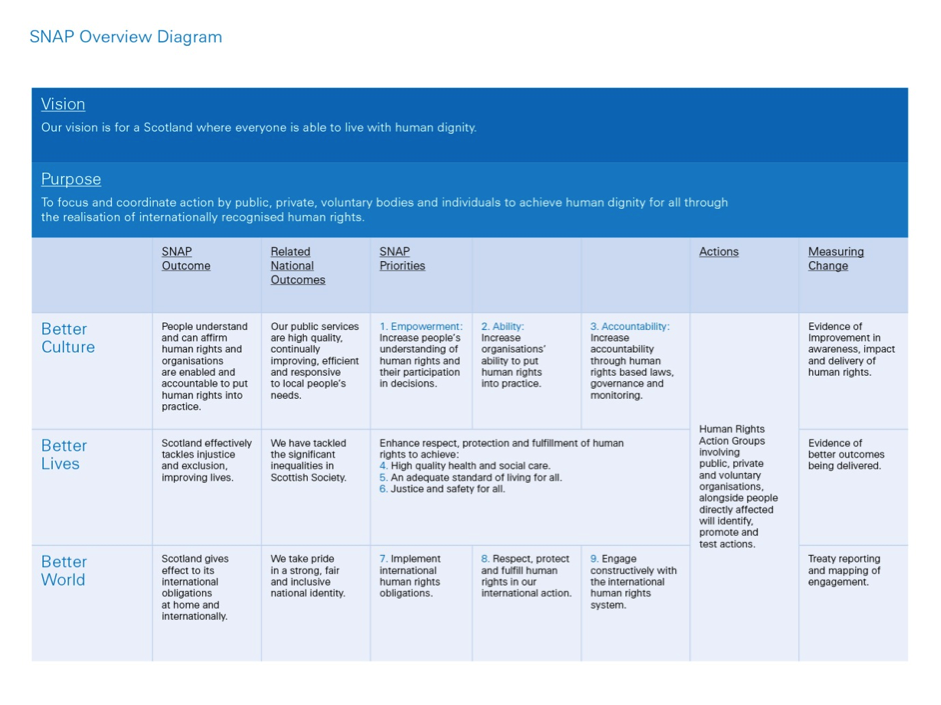On 10 December 2013, Scotland launched its first National Action Plan for Human Rights (SNAP). It is based on a three year evidence gathering project and broad participation from civil society, public bodies and people with direct experience.
The vision, purpose and priorities of SNAP are outlined below and cover a wide range of civil, political, economic, social and cultural rights. A short animation was created to highlight to people living in Scotland what SNAP is all about.

SNAP is coordinating action by a wide range of public bodies and voluntary organisations towards achieving this vision. It is not a traditional action plan but a transformative programme of action including agreed outcomes, priorities and a process for working together from 2013 – 2017 to progressively realise the potential of human rights in all areas of life.
Advice from the Council of Europe Commissioner for Human Rights has highlighted that evaluation must form a key component of any action plan, ideally from the start. Since the launch of SNAP, as the Commission’s research officer, I have been involved with developing a Monitoring framework for SNAP. The first step involved bringing together a group of experts to guide us through that process.
Following discussions with the OHCHR and the Swedish Ombudsman (who evaluated Sweden’s NAP), the monitoring group is developing an outcomes-focused framework that is flexible enough to adapt to a non-traditional ‘living’ and thematic Action Plan. The group is adopting a Theory of Change methodology (ToC) to develop this framework. It is essentially an outcomes-based theory which starts with what you want to achieve and works backwards towards the actions required, whilst along the way articulating the underlying assumptions of your theory.
The idea behind this approach is that, as time progresses, you can assess your progress against the intended outcomes and test the theory – is it working as expected? Were the basic assumptions right? Are there any unintended outcomes that need to be explored? Does the theory need to be adjusted in light of this analysis? The process allows you to periodically check and test base assumptions and adjust the Action Plan to ensure that it reaches the desired outcomes.
Once an outcomes map and time-bound targets have been finalised and agreed by all of the SNAP working groups, they must develop relevant human rights indicators, which will be used to track progress.
Measuring progress in human rights outcomes can be very difficult. Human rights indicator sets have been developed by the OHCHR , the FRA and in Great Britain the Human Rights Measurement Framework (HRMF) was modelled on the work of the OHCHR. However, translating their applicability for monitoring SNAP has been a challenge because of the thematic way in which SNAP is set out, rather than examining the enjoyment of human rights, right by right.
The process of developing a monitoring framework has raised a number of questions:
- The ToC originated in the US and has been growing in popularity over the last decade in the UK. Have you or your organisation utilised a ToC in your work? If so, how well have you found this approach work for evaluation?
- We are keen to develop time-bound targets for SNAP’s long, intermediate and short term outcomes, but we wonder whether defining quantitative targets might encourage stakeholders to aim only for a minimum achievement level. What has been your experience with this?
- In developing relevant indicators we are looking beyond the measurement frameworks identified above for, for example, the post-2015 Sustainable Development Goals. In that regards, what other indicator frameworks could help, especially in order to capture information related to economic, social and cultural rights?
- For programmes of action such as SNAP, with such a wide range of action areas, how might you approach the balance to avoid having either too few or too many indicators?
- Finally, how do you get the balance right between selecting indicators that can be measured versus ones that should be measured but for which data is not currently available?
We would be eager to know of the experiences of others with regards to these questions.
* Alison has been the Research Officer at the Scottish Human Rights Commission since its creation in 2008. She came from a background of over 10 years of experience in the field of Social Policy. She has previously researched a wide range of topics with a particular interest in young people’s right to health care and pregnant and parenting teenagers’ right to education see: www.alisonhosie.co.uk Since joining the commission she has been involved in evaluating the practical application of human rights based approaches and developing an evidence base for Scotland’s first National Action Plan for Human Rights.
